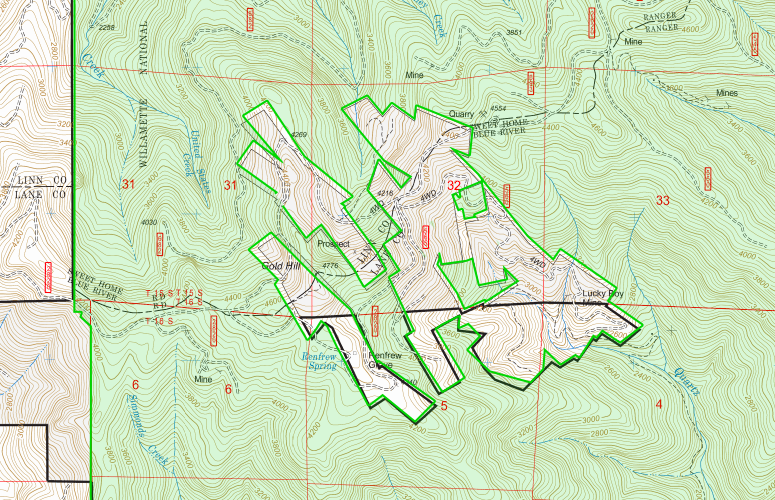
The Blue River Mining district is situated on the border of Lane and Linn Counties in Western Oregon. This district has produced a relatively small amount overal, with nearly all of the recorded production coming from just a few mines.
This is an easily overlooked area for gold prospectors. One reason is that it is well outside of the known gold-bearing regions in the states. Located about 45 miles west of Eugene, the nearest (very small) town is called Blue River, about 4 miles directly south.
The Blue River district is isolated from the more abundant gold mines of Jackson and Josephine Counties. But despite its small size, the area does hold a few opportunities for small-scale prospectors. Let’s first learn a bit about the history and geology of this area.
The Mines
Only a handful of mines here have produced any significant quantities of gold. The Lucky Boy Mine was the biggest of them all. The first auriferous gold veins were discovered in 1887. An estimated $100,000 in gold is extracted from the mine in the first decade of operation. Mining continued through the mid-1920s with diminishing returns.
Just over the ridge to the north is the location of the Great Northern Mine, another decent gold producer for a few years. It has been credited with around 1,200 ounces of gold. Other mines include the Rialto Mine, Treadwell Mine, Union Mine, Durango Mine, and Poorman Mine. Production records are hard to come by, but overall production is likely quite small.
The mineable quartz veins contain chalcopyrite, galena and pyrite among other minerals, but veins are sporadic and difficult to follow, creating challenges for the early miners.

The Blue River Mining District is situated on the border of Lane and Linn Counties in Western Oregon. Most of the mines are situated on patented mining claims, but it is surrounded by National Forest land. Surrounding creeks and rivers like the Calapooia and McKenzie Rivers do carry fine gold.
Also Read: Staking a Gold Mining Claim
Calapooia, McKenzie & Blue River Gold
The Blue River district sits on the ridge dividing the McKenzie River to the south and the Calapooia River to the north. It should be no surprise that gold can be panned from both of these rivers. However, don’t expect to get rich.
Similar to other mining areas in this general area (Quartzville, Molalla River, etc.) you can expect some tiny specks for your efforts. The gold is small enough that it can be tough to capture in a sluice, but careful gold panning can result in some gold if you are persistent.
Since the source of this gold is likely from oxidized veins shedding gold over millennia, it is fair to surmise that accessing placers that are closer to the source will likely result in better gold.
Access can be a challenge, but there are several drainages that drain the mineralized area that are likely to be worth exploring. Northwest of Blue River Lake you will find two major drainages that will likely contain gold; Quartz Creek and Simmonds Creek. Both flow south from the Blue River Mines.
On the Calapooia side of the mountain, you might check out United States Creek, or either fork of Kinney Creek. The closer you can get to the hard rock mines the better odds of finding placer concentrations in the creeks. There is a lot of public land in this area. Just remember that you will need to check mining claim status before you do any prospecting.
12 of the Richest Gold Mines in Oregon
Oregon Coast Gold Panning – Find Gold on the Beach

